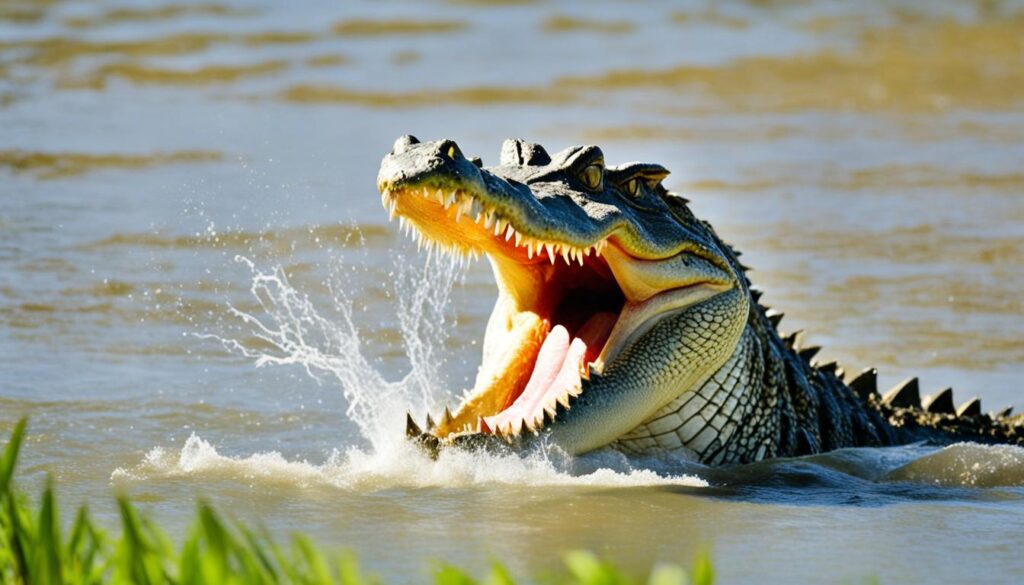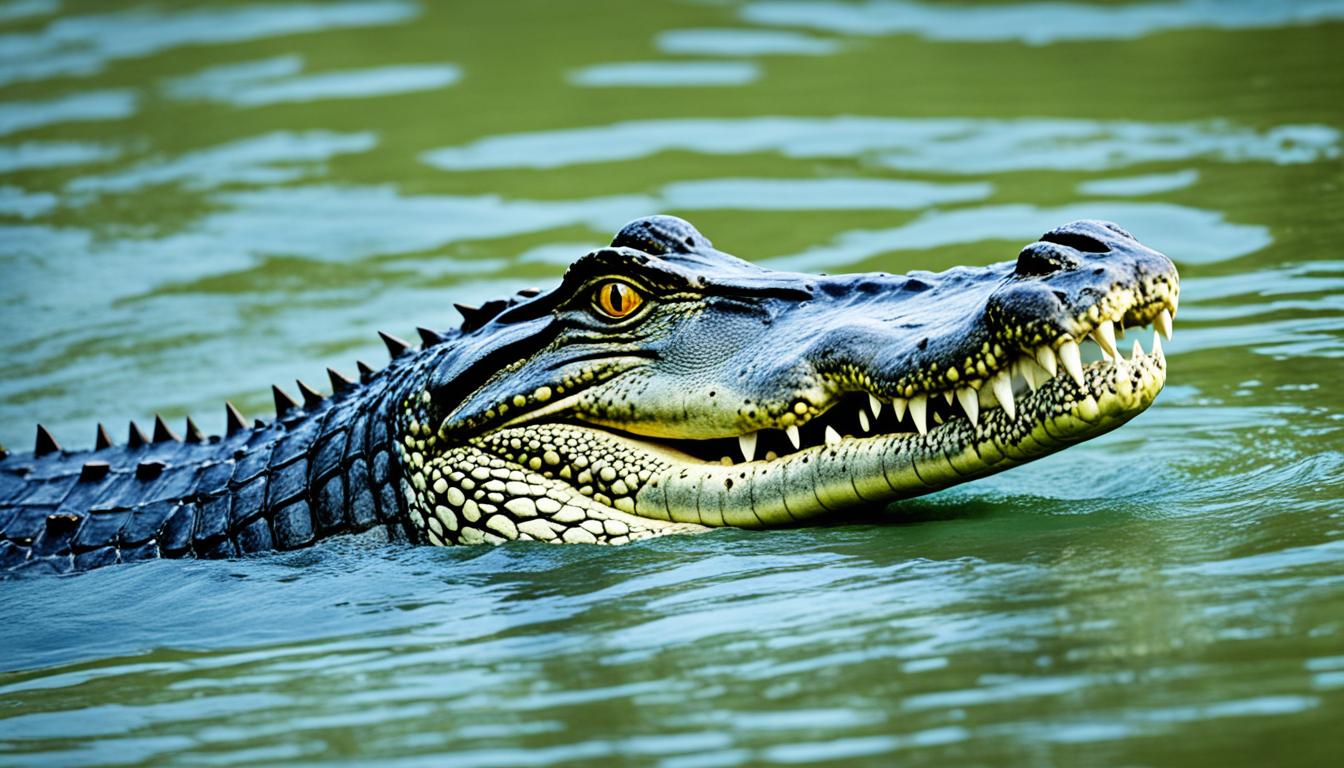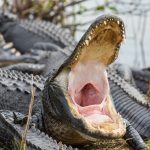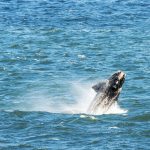Crocodiles have been around for over 200 million years. They have amazing crocodiles adaptations that help them live in both water and on land. These reptiles are well-suited for the humid tropics, where they live.
Have you ever thought about how crocodiles manage to survive in both worlds? Their body structure and how they behave are key to their success. Let’s explore how they’ve adapted to different environments over time.
Crocodile Anatomy: Built for Dual Environments
Crocodiles have amazing anatomy that lets them live in both water and on land. Their body features help them survive and thrive in different places. This shows how their unique body parts support their lifestyle and behavior in various habitats.
Physical adaptations for aquatic life
Crocodiles have special features for living in water. Their nostrils, eyes, and ears are on top of their heads. This lets them stay mostly underwater, which is great for hunting and hiding.
Underwater, they use skin flaps to cover their ears and muscles to shut their nostrils. This helps them move smoothly through the water. Their long, strong tails help them swim fast and move through the water easily.
These traits are crucial for their life in the water. They show how well crocodiles are adapted for aquatic life.
Land adaptations and mobility
On land, crocodiles are surprisingly agile. Their strong muscles help them move on different surfaces. Despite being big, they can run fast, especially when they feel threatened.
This mix of strength and speed is interesting. It shows how their body structure helps them live on land. Their strong bodies and flexible movement are key for hunting and avoiding predators on land.
How do crocodiles survive in both water and land?
Crocodiles have special ways to live in both water and on land. They are very good at adapting to different environments. This shows how they can survive in many places.
Behavioral strategies for survival
Crocodiles are experts at staying still to catch their prey. They sit quietly by the water, waiting for the perfect time to attack. This way, they save energy and have a better chance of catching food.
- Ambush hunting techniques enhance feeding efficiency.
- Social interactions include vocalizations and body postures.
- Territorial displays help avoid conflicts with competitors.
Temperature regulation techniques
Since crocodiles are cold-blooded reptiles, they need to control their body temperature. They use different ways to stay at the right temperature. By basking in the sun, they warm up. And when it’s too hot, they find shade or go into the water to cool down.
| Technique | Purpose |
|---|---|
| Basking | Absorbs warmth to elevate body temperature |
| Seeking shade | Reduces body temperature during peak sunlight hours |
| Water immersion | Cool down and maintain optimal metabolic efficiency |
Crocodiles’ Habitat Preferences
Crocodiles live in warm and humid places. They choose their homes carefully to survive. You can find them in swamps, rivers, and estuaries. These spots let them live in water and on land.
They need freshwater, good hunting spots, and sunny places to bask. These things affect their behavior a lot.
Typical environments of crocodiles
Crocodiles like different habitats for different reasons. Important places for them include:
- Swamps
- Rivers
- Estuaries
- Coastal areas
- Lakes
These places help them hunt, breed, and rest. They are key for their survival.
Impact of habitat on crocodile behavior
The place where crocodiles live changes how they act. If there’s lots of food, they hunt a lot. But if food is rare, they stay still to save energy.
Here’s a table that shows how their habitat affects their behavior:
| Habitat Feature | Effect on Behavior |
|---|---|
| Availability of Freshwater | Supports hydration, promotes breeding. |
| Proximity to Prey | Increases hunting frequency and aggression. |
| Shelters for Basking | Encourages sunbathing, aids in temperature regulation. |
| Human Interaction | May lead to altered behaviors due to stress or competition. |
The Diet of Crocodiles: Adaptation and Survival
Crocodiles’ diets are key to their survival and adaptation in different habitats. Their eating habits change from when they are young to when they grow up. This shows how versatile these reptiles are. Young and adult crocodiles eat different foods based on their size and where they live.
Young crocodile feeding habits
Young crocodiles eat specific foods that fit their size and growth stage. Their diet includes:
- Insects
- Small fish
- Amphibians
These foods are important for their growth and help them learn how to hunt. By eating small prey, they get the nutrients they need and prepare for a varied diet later. Learning to hunt small creatures is crucial for their survival as they grow.
Adult crocodile dietary preferences
Adult crocodiles eat a lot more than young ones. They are opportunistic predators, eating a variety of prey, such as:
- Fish
- Birds
- Mammals
They have strong jaws and adaptations that help them catch their prey. They use a sideways motion to grab fish and can ambush animals on land near water. This shows their hunting skills and is key to their survival in different places.

| Age Group | Typical Diet | Feeding Technique |
|---|---|---|
| Young | Insects, Small Fish, Amphibians | Ambush and Quick Attacks |
| Adult | Fish, Birds, Mammals | Ambush and Powerful Jaws |
This structured diet is crucial for crocodiles’ survival. It highlights their adaptations to their environments. Knowing about their diet helps us understand their role in the ecosystem and how they act as predators.
Crocodiles’ Unique Behavioral Characteristics
Crocodiles have fascinating behaviors that help them survive in water and on land. Their hunting skills show how adaptable they are in different environments. Learning about these traits helps us see their importance in nature and their complex behaviors.
Predatory tactics in water and on land
Crocodiles are skilled hunters, using stealth and strength to catch their prey. In the water, they wait and strike when the time is right. They stay hidden, then move fast for a surprise attack.
On land, they stalk their prey quietly. They can stay still for a long time, blending in with their surroundings. This way, they can catch animals off guard without using much energy.
Social behavior and communication
Crocodiles are not just hunters; they have complex social lives. They make sounds like grunts and roars, especially when breeding. These sounds help them talk to each other and keep their social groups stable.
They also use body language and smells to share information and show who’s in charge. This helps them organize their groups and get to the best spots for sunning and nesting.
The Life Cycle of Crocodiles: From Hatchling to Adult
The life of a crocodile starts with the hatching of eggs. A clutch usually has 20 to 50 eggs. Mom buries them in sand or mud near water. After 65 to 100 days, the hatchlings come out, about 20 to 30 cm long.
Growth patterns and age progression
Young crocodiles face many dangers right after they hatch. They can be eaten by other animals. The first few years are very important for their survival. They can grow up to 30 cm a year if things are good for them.
They become adults around age 10, reaching 1.5 to 3 meters long. This is when they are ready to have babies of their own.
Challenges faced during early life stages
The first years of a crocodile’s life are tough. They have to deal with big fish, birds, and other crocodiles. This makes it hard for them to survive. They also fight for food and space, making things even harder.
Learning about these challenges helps us understand how crocodiles make it through their early years. It shows us how they survive and grow.
| Stage | Average Length | Age | Key Challenges |
|---|---|---|---|
| Hatchling | 20-30 cm (8-12 in) | 0-2 years | Predation, resource competition |
| Juvenile | Up to 1.5 m (5 ft) | 2-10 years | Territory disputes, larger predators |
| Adult | 1.5-3 m (5-10 ft) | 10 years and older | Human interference, habitat loss |
Crocodiles and Environmental Adaptation
Crocodiles are amazing creatures that have adapted well to many environments. They live in freshwater lakes, brackish waters, and coastal areas. Their survival depends on their ability to adapt to different ecosystems.
But, human actions threaten their survival. Habitat loss, pollution, and hunting harm their homes. This forces them into smaller spaces. It’s important to understand and address these issues to help them survive.
Conservation efforts are underway to protect crocodiles and their homes. These programs teach the value of sustainable living. They show how important it is to keep ecosystems balanced. By supporting these efforts, we can learn more about these incredible animals and their habitats.










